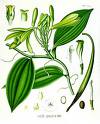Introduction
The descriptions of honey, fruit, grapes and spices here were originally in the BJCP Mead Exam Study Guide. They were moved to this standalone document so they could be more easily used for multiple purposes and be referenced by other BJCP documents.
topHoney
Honey varieties referenced on the mead exam were based on an analysis of actual varieties declared in many large mead competitions over several years. The data was collated and the 21 most frequently-occurring varieties were selected for inclusion on the mead exam. This means that a mead judge studying this information is likely to understand most honey varieties that are seen in actual competitions.
The honey varieties are often quite regional, so not all varieties will be seen in all competitions. Some of the rare or obscure honey varieties might be quite common in some regions. However, in large competitions that draw entries from all over the country, a wider distribution of honey varieties will be encountered.
The honey varieties are described with the following data:
- Floral source – type of plant blossom from which the honey is derived
- Location – region where commonly found
- Color – honey – the color of the honey in raw form
- Color – mead – the color of a mead made with the honey (assuming no added ingredients)
- Aroma – the characteristic aromatic qualities of the honey
- Flavor – major flavors in the honey
- Substitutes – other honey varieties that may be used
- Confused with – other honey varieties that might be mistaken for the specific variety
- Best for – recommended mead styles where the honey could best be featured.
- Goes well with – types of adjuncts or ingredients that complement the honey character.
- Notes – general comments about the honey.
Honey Attributes
There are a range of descriptors that are commonly used to describe honey. Note that the color, aroma and flavor of honey may be different than that found in the resulting mead. Fermentation and aging alters the perception of some of these attributes, as well as adding additional components.
topColor
The U.S. Department of Agriculture classifies honey into seven categories: water white, extra white, white, extra light amber, light amber, amber and dark amber.
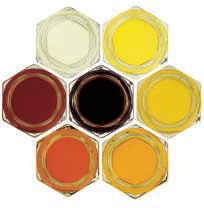
These are determined by a color grader using the Pfund scale, a visual system peculiar to the honey industry. A table of equivalences between Pfund readings and color names was created to allow common names to be used, although the names do not always make sense (e.g., buckwheat is hardly “dark amber” in color).
Color is not an indicator of honey quality, although the naming system is widely used by honey producers. The color of honey is characteristic of its floral source due to minerals and other minor components. Exposure to heat and storage time may affect a honey’s color (typically darkening and losing intensity of color with age/heat). A honey that is darker than expected may not have been stored properly. Honey that has granulated (developed crystals) will also appear lighter in color than clear honeys.
Generally, lighter honeys have a milder flavor and darker honeys have a more robust flavor, but many exceptions exist (e.g., basswood is light in color but with a strong flavor while tulip poplar honey is dark colored and mild tasting). So, while color may give some indication of expected flavor and aroma, this is not a perfect model.
Flavor and Aroma
The flavor and aroma components of unfermented honey are good indicators of what character you can expect from a varietal mead. However, they aren’t exactly the same. Just as you don’t expect wine to smell like unfermented grapes, the character of fermented honey is different from raw honey. Since there hasn’t been much formal research into mead, we have to rely on the research done from the honey industry (the National Honey Board in particular) to describe the nature of the honey.
Following are some common terms used when describing honey:
- Sweet. Sweet, sugary, honey-like aroma and flavor. Self-descriptive, really.
- Floral. Flowery aroma like fresh blossoms, the smell of nectar. Suggestive of fresh blooming flowers.
- Perfumy. A more fragrant and intense floral-like aroma, typically more concentrated.
- Citrusy. A character reminiscent of citrus fruit, such as oranges, lemons, limes or grapefruit.
- Herbal. A character reminiscent of herbs, such as mint, eucalyptus, or other aromatic plant leaves (fresh or dried). Can also be extended to tea-like character.
- Grassy. Suggestive of fresh cut grass.
- Green leaves, vegetal. A character like bruised tomato leaves, blackberry leaves or other green plant matter (not of unripe fruit).
- Woody. Suggestive of woody stems, herbs, or evergreens.
- Earthy. Suggestive of freshly turned soil, mushrooms, truffles, sometimes also mold.
- Molasses. Suggestive of molasses, sorghum, treacle, or dark brown sugar.
- Caramelized. Associated with browned (caramelized) sugars of varying depths and intensities, not burnt sugar. Toffee.
- Nutty/toasty. Characteristic of almonds, hazelnuts, and toasted bread.
- Dried fruit. Esters associated with dried fruit such as raisins, dried cherries, or prunes.
- Fruity. Esters reminiscent of ripe or nearly ripe tropical fruit, bananas, apricots, pears, apples, peaches, melons, or just suggestive of generic fruit quality.
- Green fruit. The character of unripe fruit.
- Spicy. Suggestive of spices (dried seed, fruit, root, bark, or vegetative substance), such as cinnamon.
- Medicinal. A character associated with medicines or chemicals, such as menthol.
- Pungent. A strong, sharp character.
- Waxy. Reminiscent of beeswax.
- Creamy. Suggestive of cream.
- Buttery. Suggestive of butter.
- Hot. Sharp, biting, possibly solventy.
- Unique varietal. Some honey varieties (such as orange blossom and clover) cannot adequately be described in terms other than themselves.
Honey Varieties
The honey varieties listed in this section are in the exam question pool:
Apple Blossom
| Floral Source: | Apple tree blossoms. | |
|---|---|---|
| Location: | Northern and central US. | |
| Color – honey: | Light, golden brown. | |
| Color – mead: | Light amber. | |
| Aroma: | Floral, hints of apple rind. | |
| Flavor: | Floral, does not taste overtly ‘appley’. | |
| Substitutes: | None. |
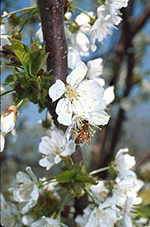 |
| Confused with: | None. | |
| Best for: | Traditional meads, cysers. | |
| Goes well with: | Apples, spices. | |
| Notes: | Very sweet honey. |
Alfalfa
| Floral Source: | Alfalfa blossoms, purple flowers. |
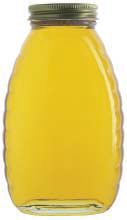 |
|---|---|---|
| Location: | Midwest, US and Canadian Great Plains and Western US. | |
| Color – honey: | White to extra light amber. | |
| Color – mead: | White to straw. | |
| Aroma: | Beeswax, hay. | |
| Flavor: | Beeswax, mild, light, delicate. | |
| Substitutes: |
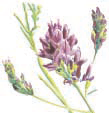 |
|
| Confused with: | Clover, wildflower. | |
| Best for: | Traditional meads. | |
| Goes well with: | ||
| Notes: | Very delicate, light honey. One of the only honeys that truly has a ‘waxy’ character that is not from poor handling. |
Basswood
| Floral Source: | Basswood (American linden, Tilia americana) tree blossoms. |
 |
|---|---|---|
| Location: | Southern Canada to Alabama and Texas. | |
| Color – honey: | Water white. | |
| Color – mead: | Straw. | |
| Aroma: | White wine, chardonnay, yeasty, mineral, unripe (green) fruit | |
| Flavor: | Green ripening fruit, lingering flavor, creamy, buttery, herbal, crisp and clean finish. | |
| Substitutes: |
 |
|
| Confused with: | Midwestern wildflower. | |
| Best for: | Melomels, metheglins, cysers. | |
| Goes well with: | Apples, vanilla. | |
| Notes: | Distinctive lingering flavor. Can be a little harsh and hot when fermented. |
Blackberry Blossom
| Floral Source: | Blackberry bramble blossoms. | |
|---|---|---|
| Location: | Pacific Northwest US. | |
| Color – honey: | White to light amber. | |
| Color – mead: | Light gold. | |
| Aroma: | Floral, leafy. | |
| Flavor: | Moderate, fairly distinctive. | |
| Substitutes: |
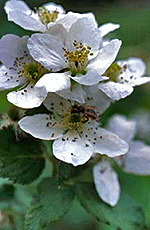 |
|
| Confused with: | ||
| Best for: | Traditional meads, melomels. | |
| Goes well with: | Blackberries. | |
| Notes: | Should not have overt blackberry fruit character |
Blueberry Blossom
| Floral Source: | Blueberry shrubs, tiny white flowers. |
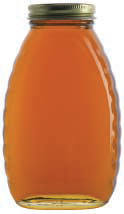 |
|---|---|---|
| Location: | Northeastern US, Michigan and Canada. | |
| Color – honey: | Light to medium amber. | |
| Color – mead: | Deep gold, should NOT be blue or purplish. | |
| Aroma: | Floral, leafy, green leaves, citrus. | |
| Flavor: | Fruity, green leaves, lemon, buttery finish. Delicate aftertaste. | |
| Substitutes: | None. |
 |
| Confused with: | ||
| Best for: | Traditional meads, melomels. | |
| Goes well with: | Blueberries. | |
| Notes: | No overt blueberry character. |
Buckwheat
| Floral Source: | Buckwheat, a plant that looks and grows similar to wheat but is actually an herb. |
 |
|---|---|---|
| Location: | Across upper Midwest US and Eastern Canada. | |
| Color – honey: | Dark amber, looks dark purple or black. | |
| Color – mead: | Deep amber to light brown. | |
| Aroma: | Unmistakable, molasses, treacle, sultanas. Fairly strong. | |
| Flavor: | Malt syrup, treacle, caramel, molasses, lingering earthy aftertaste, full-bodied. Pungent. Buckwheat pancakes. | |
| Substitutes: | Avocado. |
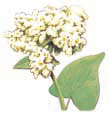 |
| Confused with: | ||
| Best for: | Dark braggots, metheglins, traditional meads. | |
| Goes well with: | Dark spices – cinnamon, nutmeg, etc. | |
| Notes: | One of the darkest honeys available. Most people either love the stuff or hate it. Takes to spices well because it is so strongly flavored. West Coast buckwheat is much lighter and milder than Midwest buckwheat. |
Clover
| Floral Source: | Blossoms of White Dutch, Sweet, Red or white clover blossoms. |
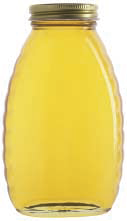 |
|---|---|---|
| Location: | Across US and Canada, very widely available, quite common. | |
| Color – honey: | Clear to light amber, commonly straw. Varies by variety. | |
| Color – mead: | Light amber. | |
| Aroma: | Sweet, slight bouquet of flowers, hints of clover fields. | |
| Flavor: | Touch of flowers, nondescript mild, “classic honey” flavor, sweet, pleasant. | |
| Substitutes: | Wildflower honey. |
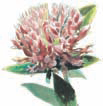 |
| Confused with: | Wildflower honey. | |
| Best for: | Melomels, traditional meads, metheglins, pyments. | |
| Goes well with: | Like a blank slate, goes well with anything. All purpose honey. | |
| Notes: | One of the most nondescript honeys. Has a very mild character that will get overpowered by anything strong flavored. A major constituent of wildflower honey in the Midwest. |
Cotton Blossom
| Floral Source: | Blossoms and leaves of cotton plant. | |
|---|---|---|
| Location: | Southern US, cotton-producing states. | |
| Color – honey: | White to light amber. | |
| Color – mead: | Golden. | |
| Aroma: | Smooth cotton blossom aroma, woody. | |
| Flavor: | Mild, cotton blossom, woody, distinctive. | |
| Substitutes: |
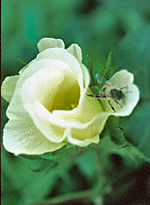 |
|
| Confused with: | ||
| Best for: | Traditional meads, metheglins. | |
| Goes well with: | Saffron. | |
| Notes: | Quite mild honey. |
Fireweed
| Floral Source: | Red-purple blossoms of the Fireweed herb, a perennial that grows immediately following a forest fire. |
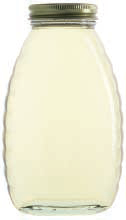 |
|---|---|---|
| Location: | Northern Pacific states and Canada. | |
| Color – honey: | Water white. | |
| Color – mead: | Straw. | |
| Aroma: | Extremely light, herbal, tea-like. | |
| Flavor: | Tea-like, delicate, sweet, fruity, with smooth finish. | |
| Substitutes: |
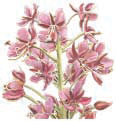 |
|
| Confused with: | ||
| Best for: | Traditional meads, light melomels. | |
| Goes well with: | Peaches, pears. | |
| Notes: | Very mild, sweet and fruity. |
Guajillo
| Floral Source: | Blossoms of wild desert bush, a medium-sized shrub that can grow into a small tree (up to 15’ tall). White flowers. |
 |
|---|---|---|
| Location: | Southwest Texas and northern Mexico. | |
| Color – honey: | Light to deep amber, but darkens with age. | |
| Color – mead: | Straw. | |
| Aroma: | Perfume-like, fragrant, herbal, touch of lavender or mint. | |
| Flavor: | Very light, mild, rich, smooth and sweet, with a hint of lavender or mint, brown sugar, vanilla. Earthy aftertaste. | |
| Substitutes: | None. |
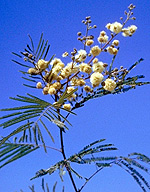 |
| Confused with: | Cotton blossom. | |
| Best for: | Traditional meads, metheglins. | |
| Goes well with: | Herbs and light spices. | |
| Notes: | Also known as Huajilla, Guajillo is a member of the Acacia plant family. Light and delicate honey with subtle complexity. |
Heather
| Floral Source: | Purple-Pink blossoms on the perennial Heather scrub, Erica vulgaris. | |
|---|---|---|
| Location: | Europe (esp. Scotland) and Asia Minor. | |
| Color – honey: | Amber, reddish-orange hues. | |
| Color – mead: | Deep amber. | |
| Aroma: | Licorice, fresh floral, perfumy, anise, caramel, candied squash. | |
| Flavor: | Vanilla, licorice, toasty, hint of maple, toffee, rich, complex, multi-dimensional. Heavy-bodied. | |
| Substitutes: | None. |
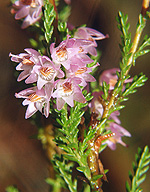 |
| Confused with: | None. | |
| Best for: | Traditional meads. | |
| Goes well with: | ||
| Notes: | One of the hardest honeys to use. Very ‘funky’ honey that requires extensive aging to mellow and smooth out. Crystallizes rapidly. |
Mesquite
| Floral Source: | Mesquite tree. | |
|---|---|---|
| Location: | Southwestern US. | |
| Color – honey: | Water white to amber. | |
| Color – mead: | Straw to golden. | |
| Aroma: | Robust earth, raw mesquite wood, NOT smoky. | |
| Flavor: | Same as aroma, dominating long finish. Hint of apple or peach. Full, complex, distinctive. Earthy aftertaste. | |
| Substitutes: | Fireweed. |
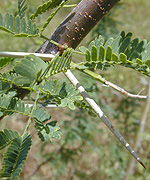 |
| Confused with: | Any varietal mead with oak (raw wood character). | |
| Best for: | Traditional meads, metheglins, melomels. | |
| Goes well with: | Hot peppers, berries. Chipotle, raspberry. | |
| Notes: | Very unique honey that nearly possesses some of the wood character of which the tree is known. Taste the distinct mesquite wood character in the honey, like food cooked with mesquite but without the smoke. Also known as Desert Blossom. |
Mint Blossom
| Floral Source: | Spearmint or other mints. | |
|---|---|---|
| Location: | Central US to New England. | |
| Color – honey: | White to amber. | |
| Color – mead: | Pale yellow to amber. | |
| Aroma: | Sweet, light mint. | |
| Flavor: | Sweet, light mint, soft flavor. | |
| Substitutes: | None. |
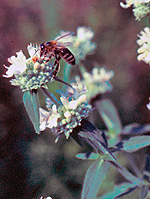 |
| Confused with: | None. | |
| Best for: | Traditional meads, metheglins, melomels. | |
| Goes well with: | Mint. | |
| Notes: |
Orange Blossom
| Floral Source: | Orange tree blossoms. |
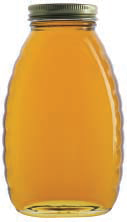 |
|---|---|---|
| Location: | California, Florida, Texas and Arizona. | |
| Color – honey: | Water white to extra light amber. | |
| Color – mead: | Straw to amber. | |
| Aroma: | Robust floral aroma. Big, fresh blossom-like, lemony, cream soda aroma, Orangina. Very distinctive. | |
| Flavor: | Orange water, citrus blossom, flowery perfumy aftertaste. | |
| Substitutes: | None. |
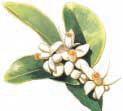 |
| Confused with: | None. | |
| Best for: | Anything. Particularly traditional meads. | |
| Goes well with: | White grapes, tannic fruits, vanilla. | |
| Notes: | This and wildflower are probably the most well rounded ‘utility’ honeys. Takes oak very well. Keeps its character even with a large amount of adjuncts added. The California variety is of better quality than the Florida. The Florida variety is much less fruity and citrusy and has more of a muddled flavor that is not as distinctly known as orange blossom. |
Palmetto
| Floral Source: | Blossoms on palmetto tree, saw palmetto. | |
|---|---|---|
| Location: | US Southeast: North Carolina to Florida. | |
| Color – honey: | Light amber to amber. | |
| Color – mead: | Straw to light gold. | |
| Aroma: | Musky, light, lemony, melony, citrusy, leafy, herbal. | |
| Flavor: | Tartness, mixed citrus (lemon, lime, orange), grapey, pyment, woody, herbal. | |
| Substitutes: | Gallberry. |
 |
| Confused with: | Gallberry. | |
| Best for: | Traditional meads, melomels. | |
| Goes well with: | Citrus. | |
| Notes: | Thinner body than most honeys. |
Raspberry Blossom
| Floral Source: | Raspberry bramble blossoms. | |
|---|---|---|
| Location: | Pacific Northwest, Upper Midwest, Upper East Coast US. | |
| Color – honey: | Light amber. | |
| Color – mead: | Golden. | |
| Aroma: | Floral, light citrus (orange, lemon). | |
| Flavor: | Floral, fruity, tangerine. Delicate aftertaste. | |
| Substitutes: | Blackberry. |
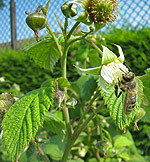 |
| Confused with: | Blackberry. | |
| Best for: | Traditional meads, melomels. | |
| Goes well with: | Peaches, pears, vanilla, chocolate. | |
| Notes: | Mellow and smooth with unique ‘green’ raspberry finish. |
Sage Blossom (White Sage)
| Floral Source: | White sage blossoms. |
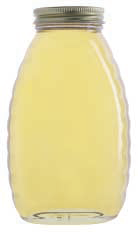 |
|---|---|---|
| Location: | California, Southwest US. | |
| Color – honey: | Water white to extra white. | |
| Color – mead: | Water white to straw. | |
| Aroma: | Herbal, elegant floral, earthy, spicy. | |
| Flavor: | Sweet and clover-like, floral, spicy, metallic, heavy body. Mild flavor, rich, light. | |
| Substitutes: | Black Button Sage, Purple Sage, Clover. |
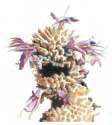 |
| Confused with: | Clover. | |
| Best for: | Traditional meads, metheglins, pyments. | |
| Goes well with: | Citrus, green tea, spices. | |
| Notes: | White sage blossom is the most common but Black Button and Purple can be found. A rich honey that is still light in color. |
Sourwood
| Floral Source: | Sourwood tree, sometimes known as Lily of the Valley tree, grows to 40-60’, blooms late, and has beautiful white bell-shaped flowers. |
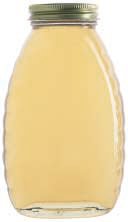 |
|---|---|---|
| Location: | Middle to Southern Appalachian mountains. | |
| Color – honey: | Extra light to light amber. | |
| Color – mead: | Straw. | |
| Aroma: | Sweet, spicy, anise, very aromatic. | |
| Flavor: | Sweet, spicy, anise, distinctive rich honey flavor, touch of sourness, pleasant lingering aftertaste. | |
| Substitutes: | Tupelo. |
 |
| Confused with: | ||
| Best for: | Traditional meads. | |
| Goes well with: | ||
| Notes: |
Star Thistle
| Floral Source: | Purple-Pink blossoms on Star Thistle herb. | |
|---|---|---|
| Location: | US West, Midwest and Florida. | |
| Color – honey: | White to extra light amber, greenish. | |
| Color – mead: | Straw, greenish tones. | |
| Aroma: | Grassy, anise. | |
| Flavor: | Grassy, anise. | |
| Substitutes: | None |
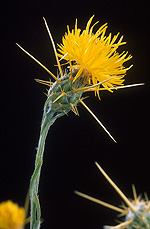 |
| Confused with: | None | |
| Best for: | Traditional meads. | |
| Goes well with: | ||
| Notes: |
Tupelo
| Floral Source: | White Tupelo (also known as Ogeechee lime) trees, growing to a height of 50-75’ and blooming from early April to early May. |
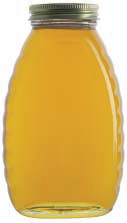 |
|---|---|---|
| Location: | South Georgia and Florida panhandle. | |
| Color – honey: | Light amber. | |
| Color – mead: | Golden. | |
| Aroma: | Apple, sweet, vanilla, herbal. | |
| Flavor: | Creamy, sherry, light cinnamon, full-bodied, mild, complex, smooth, distinctive. | |
| Substitutes: | None |
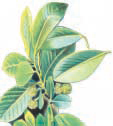 |
| Confused with: | None | |
| Best for: | Traditional meads, melomels, metheglins, pyments. | |
| Goes well with: | Spices, tannic fruits. | |
| Notes: | Very complex floral, herbal and fruity honey. Because of the price of Tupelo honey its usually used alone in a traditional mead of which it takes to oak very well. The high ratio of fructose to glucose is such that this honey does not crystallize and because of such is one of the sweetest honeys available. Inasmuch, Tupelo meads will usually taste sweeter than a mead made with different honey. |
Wildflower
Note: “Wildflower” is not a variety, yet it is the most commonly declared type of honey that a mead judge will see in a competition. Rather than quibble about semantic matters, the general honey characteristics are described. Wildflower can mean honey from unknown blossoming plants, or polyfloral honey from multiple sources. It often reflects the dominant wild plants in a region, perhaps Clover. It varies greatly by region and season.
| Floral Source: | ANY blossom(s). | |
|---|---|---|
| Location: | Any/all. | |
| Color – honey: | Light to dark, usually light. | |
| Color – mead: | Light to dark, usually light. | |
| Aroma: | Varies, often generic floral character, usually not distinctive. | |
| Flavor: | Varies, often generic floral character, usually not distinctive. | |
| Substitutes: | Varies, usually not distinctive. | |
| Confused with: | Major constituent nectar, clover. | |
| Best for: | Melomels, braggots, anything that will use strong adjunct flavorings. | |
| Goes well with: | Varies. | |
| Notes: |
Fruit
The fruit varieties listed in this section came from a survey of mead competition data. The most commonly declared fruit were categorized and described. For each fruit, we list a description or definition, the source or region where typically grown, the food or product most closely associated with the fruit (if not served raw/whole), and the color, aroma and flavor contributions from the fruit. Generally, we are describing the color, aroma and flavor of the unfermented fruit, but in some cases how the fruit affects mead when fermented is identified.
This is a database of the most common fruit that mead judges will encounter in a competition, and is what is covered on the mead exam. There are certainly many more varieties of fruit that may be used. Grapes are covered in their own section, and include associations with wine varieties that make use of the grapes. Grape varieties are commonly declared when making pyments. Note that we are not defining apple varieties in detail since meadmakers rarely specify varieties of apples in cysers entered in competition. Blended cider is typically used to create cysers rather than single-variety juice.
Fruit in Mead
Note that fermented fruit can have quite a different character than fresh fruit. Sweetness often is a strong part of the mental association between fruit flavors and the fruit themselves. If the sweetness is fermented out, the remaining flavors might not be readily identifiable as the source fruit. Identifying fruit in a dry mead can be particularly tricky.
Different fruit are more distinctive and intense than others, but all have their own flavor and aroma characteristics (even if only identifiable by their general class, like berries or stone fruit). Some fruit cannot be described without using self-referential terms; their aroma, flavor or color is the definition (e.g., the color orange). Fruit have varying sweetness, acidity, tannin and fruit flavor. Fruit typically contribute a distinctive color to the mead.
Apple
| Description or definition: | Dependent on variety – can be sweet or tart. Crisp or soft. Round fruit. Varying sweetness, acidity, tannin, and fruity flavors. Commercial cider is typically a blend of apple varieties, with varying sweetness, acidity, tannin and fruit flavor. Apples contain malic acid. |
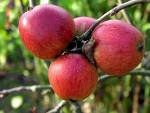 |
|---|---|---|
| Source or region: | Cool climates worldwide. | |
| Food or product: | Apple Juice, Apple Pie, Apple Cider. | |
| Color: | Red, green or golden skin. White to off-white flesh. Contributes a straw to golden color to mead. | |
| Aroma: | Cidery, apple, sweet, tart. | |
| Flavor: | Sweet, tart, apple. |
Apricot
| Description or definition: | Small fleshy stone fruit, yellow to deep orange colored, with a large almond-like pit. |
 |
|---|---|---|
| Source or region: | Native to eastern Asia. | |
| Food or product: | Pies, juices, fruit concentrate. | |
| Color: | Golden orange. Produces a mead with a pink-orange tint. | |
| Aroma: | Strong, peach-like aroma. | |
| Flavor: | Apricot, sweet. Adds acidity. Mild flavored. |
Banana
| Description or definition: | Long, curved yellow tropical fruit that grows in bunches. The flesh, ivory-white to yellow or salmon-yellow, may be firm, astringent, even gummy with latex when unripe, turning tender and slippery, or soft and mellow or rather dry and mealy or starchy when ripe. |
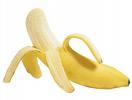 |
|---|---|---|
| Source or region: | Tropics. | |
| Food or product: | Fresh Fruit, Pies, Breads. | |
| Color: | Pale, creamy. | |
| Aroma: | Banana. | |
| Flavor: | Creamy, banana. |
Black Currant
| Description or definition: | Small round black fruit. |
 |
|---|---|---|
| Source or region: | Originated in Tibet. | |
| Food or product: | Crème de cassis liqueur, jams, jellies, preserves, Kir Royale cocktail. | |
| Color: | Deep purple to black. | |
| Aroma: | Berry-like, pungent. Can be slightly catty. | |
| Flavor: | Pleasant, aromatic, slightly sour taste, pungent, tannic. Adds considerable tannin and moderate acidity. Produces a vinous character in mead. Strongly flavored. |
Black Raspberry
| Description or definition: | Dark deep red fruit is an aggregate of drupelets. |
 |
|---|---|---|
| Source or region: | Indigenous only to North America, most abundant in the east. | |
| Food or product: | Preserves, jam, jelly, bakery products, frozen fruit, juices, extracts, ice cream, yogurt, canned. | |
| Color: | Deep dark red. | |
| Aroma: | Raspberry. | |
| Flavor: | Raspberry, sweet, tart. |
Blackberry
| Description or definition: | Grown on brambles in an aggregate of drupelets. |
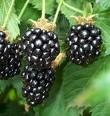 |
|---|---|---|
| Source or region: | Oregon, Native to Asia, Europe, North and South America. | |
| Food or product: | Fresh, Jelly, Pie, Fruit Concentrate, Juice. | |
| Color: | Deep purple. | |
| Aroma: | Fruity, blackberry. | |
| Flavor: | Fruity, blackberry. Adds acidity and tannin. Strongly flavored. |
Blueberry
| Description or definition: | Round berry, smooth purple-blue skin, firm. |
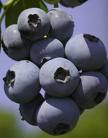 |
|---|---|---|
| Source or region: | Michigan, Wisconsin, Minnesota. | |
| Food or product: | Fresh, Jelly, Pie, Juice, Fruit Extract, Fruit Concentrate. | |
| Color: | Bluish purple, produces a purple-pink color in mead. | |
| Aroma: | Fruity, berry-like, delicate. | |
| Flavor: | Fruity, berry-like (not like blueberry pie). Adds acidity and tannin. Fruit character is subtle. |
Boysenberry
| Description or definition: | Cross between a raspberry, blackberry, and loganberry. Looks like a large raspberry, with a raspberry-like flavor. |
 |
|---|---|---|
| Source or region: | Native to California. | |
| Food or product: | Fresh, Pie, Jelly. | |
| Color: | Deep maroon, red wine. | |
| Aroma: | Fruity, raspberry-like. | |
| Flavor: | Raspberry-like. |
Cherry
| Description or definition: | Stone fruit, typically red although some varieties are golden. European varieties typically are more dark, complex and intense. Sweet and tart varieties. |
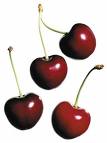 |
|---|---|---|
| Source or region: | Michigan, Wisconsin, Eastern Europe. | |
| Food or product: | Pie. | |
| Color: | Red to deep reddish-purple. Produces a mead that has a deep reddish to reddish-brown color. | |
| Aroma: | Fruity, cherry. | |
| Flavor: | Cherry, sweet or tart. Some associate with artificial flavoring, such as in medicines. Cherry pits can also be used to add an almond-like character. Tart cherries add acidity. |
Cranberry
| Description or definition: | Small red berry growing on bushes in bogs. |
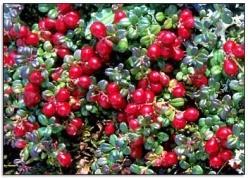 |
|---|---|---|
| Source or region: | New England, Wisconsin. | |
| Food or product: | Cranberry relish, juice. | |
| Color: | Bright red. | |
| Aroma: | Berry-like. | |
| Flavor: | Very tart. Strongly flavored. |
Elderberry
| Description or definition: | Very small, blue-black to black berries grow in clusters. |
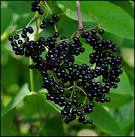 |
|---|---|---|
| Source or region: | North American and Europe. | |
| Food or product: | Wines, jellies, pies, sauces. | |
| Color: | Purple-black. | |
| Aroma: | Berry-like. | |
| Flavor: | Tart, astringent, berry. Adds considerable tannin. |
Huckleberry
| Description or definition: | Like a small blueberry, intense in flavor. |
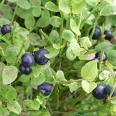 |
|---|---|---|
| Source or region: | US, Canada. | |
| Food or product: | Pie, jam. | |
| Color: | Dark Purple. | |
| Aroma: | Huckleberry, intense. | |
| Flavor: | Intense, strong flavor of huckleberry. |
Key Lime
| Description or definition: | Yellow-green citrus fruit. (Green when unripe, ripens to yellow). |
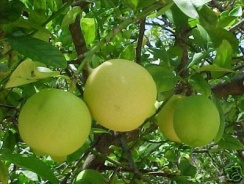 |
|---|---|---|
| Source or region: | Florida. | |
| Food or product: | Key lime pie. | |
| Color: | Yellow-green, pale green. | |
| Aroma: | Citrus, tart. | |
| Flavor: | Citrus, tart, lime; not as tart/strong as a lime. |
Lemon
| Description or definition: | Bright yellow citrus fruit. |
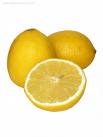 |
|---|---|---|
| Source or region: | Florida, California. | |
| Food or product: | Lemonade. | |
| Color: | Pale yellow. | |
| Aroma: | Citrus, tart. | |
| Flavor: | Citrus, tart, lemon. Adds considerable acidity. Zest is often used to impart essential oils more than acidity. |
Lime
| Description or definition: | Deep green citrus fruit (Persian lime). |
 |
|---|---|---|
| Source or region: | Florida, California. | |
| Food or product: | Lime juice. | |
| Color: | Pale green. | |
| Aroma: | Citrus, tart. | |
| Flavor: | Citrus, tart, lime. Adds considerable acidity. Zest is often used to impart essential oils more than acidity. |
Mango
| Description or definition: | The flesh of the mango is peach-like and juicy. The flavor is pleasant and rich and high in sugar and acid. |
 |
|---|---|---|
| Source or region: | Tropics. Native to southern Asia, now grown in California. | |
| Food or product: | Fresh or as juice. | |
| Color: | Yellow Pink flesh. Adds an orange-golden tint to mead. | |
| Aroma: | Peach/melon-like. | |
| Flavor: | Peach/melon flavors, acidic. |
Marionberry
| Description or definition: | Cross between a blackberry and a black raspberry. |
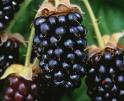 |
|---|---|---|
| Source or region: | Oregon. | |
| Food or product: | Jams, jellies, preserves, fruit wine. | |
| Color: | Purple. | |
| Aroma: | Blackberry, fruity. | |
| Flavor: | Fruity, blackberry. |
Mulberry
| Description or definition: | Collective fruit, succulent, fat, and full of juice, similar in appearance to the individual drupe of a blackberry. |
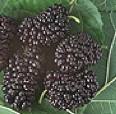 |
|---|---|---|
| Source or region: | Native to Eastern and Central China. | |
| Food or product: | Fresh, Jelly. | |
| Color: | Reddish-purple. | |
| Aroma: | Berry-like. | |
| Flavor: | A good balance of sweetness and tartness sometimes reminiscent of grapefruit. |
Orange
| Description or definition: | Orange-colored round citrus fruit. |
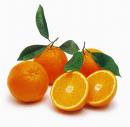 |
|---|---|---|
| Source or region: | Florida, California. | |
| Food or product: | Fresh, frozen concentrate, juice. | |
| Color: | Orange. | |
| Aroma: | Orange. | |
| Flavor: | Orange, sweet. Adds acidity. Zest is often used to impart essential oils more than acidity. |
Passion Fruit
| Description or definition: | Purple-brown round tropical fruit with orange flesh. |
 |
|---|---|---|
| Source or region: | Brazil. | |
| Food or product: | Sherbet, Confectionary, Drinks. | |
| Color: | Orange. | |
| Aroma: | Perfumy, musky, tart. | |
| Flavor: | Musky, sweet-tart, perfumy. |
Peach
| Description or definition: | Round stone fruit with orange or white flesh and fuzzy skin. |
 |
|---|---|---|
| Source or region: | South East region of the United States, originated in China. | |
| Food or product: | Fresh, pie, fruit concentrate. | |
| Color: | Pale yellow flesh. Produces a mead with a pinkish-golden color. | |
| Aroma: | Fruity, peachy. | |
| Flavor: | Fruity, peachy. A subtle fruit in mead. |
Pear
| Description or definition: | Rounded shape that becomes narrower towards the stalk. Table (eating) pears and perry pears can be used, as in perry. Culinary pears are sweeter and perry pears have higher tannin and acidity levels. |
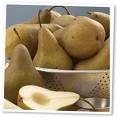 |
|---|---|---|
| Source or region: | Europe and Asia. | |
| Food or product: | Fresh, canned, used in baking. | |
| Color: | Brown to gold to green to red skin, off-white flesh. | |
| Aroma: | Fruity, pear. | |
| Flavor: | Fruity, pear. A subtle fruit in mead. |
Pineapple
| Description or definition: | Oval to cylindrical shaped. It is both juicy and fleshy with the stem serving as the fibrous core. |
 |
|---|---|---|
| Source or region: | Tropics. | |
| Food or product: | Fresh, canned or as juice. | |
| Color: | The rind may be dark green, yellow, orange-yellow or reddish when the fruit is ripe. The flesh ranges from nearly white to yellow. | |
| Aroma: | Sharp, tart, pineapple. | |
| Flavor: | Sweet or tart, Pineapple, melon-like. |
Plum
| Description or definition: | Round stone fruit, purple-black, red, or yellow color, firm with thin skin and soft flesh of varying color, typically deep amber. |
 |
|---|---|---|
| Source or region: | Asia and Southern Europe. | |
| Food or product: | Fresh, Jams, Juices. | |
| Color: | Purple-black, Red, or Yellow. Produces a mead that is moderate purple to orange or reddish-brown color. | |
| Aroma: | Plum, soft. | |
| Flavor: | Sweet, juicy. |
Pomegranate
| Description or definition: | Nearly round yellow with deep pink or red coloring and a tough leathery skin or rind. |
 |
|---|---|---|
| Source or region: | Native to Iran and the Himalayas in northern India. | |
| Food or product: | Fresh, juice, jellies, sorbet. | |
| Color: | Red, pink or whitish pulp. Purple-red seeds are what is used. Adds a purplish tint to mead. | |
| Aroma: | Tart. | |
| Flavor: | Sweetly acidic, juicy. Adds acidity and tannin. |
Prickly Pear
| Description or definition: | Cactus – Pad is flat and fruit is oval in shape. Both Pad and fruit have sharp spines. |
 |
|---|---|---|
| Source or region: | American Southwest deserts. | |
| Food or product: | Fruit is edible – sold in stores as “tuna.” Pad is also edible – eaten as a vegetable and sold in stores as “Nopalito”. Prickly Pear Nectar is made from the juice and pulp of the fruit. | |
| Color: | Pads – Blue Green; Fruit is red, purple, brown. Nectar is fuchsia. |
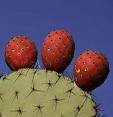 |
| Aroma: | ||
| Flavor: | Can add a dry, dusty, or powdery taste, overlaid on a sweet background. |
Raspberry
| Description or definition: | Indigenous to Asia minor and North America. Red fruit found in an aggregate of drupelets. |
 |
|---|---|---|
| Source or region: | Cool climates. | |
| Food or product: | Jam, tart/pastry fillings. | |
| Color: | Red. Produces a mead with a pinkish to deep red color. | |
| Aroma: | Raspberry, sweet, tart, intense. | |
| Flavor: | Raspberry, sweet, tart. Adds acidity and tannin to mead. Strongly flavored. |
Red Currant
| Description or definition: | Small red berries. |
 |
|---|---|---|
| Source or region: | Native to Northern Europe. | |
| Food or product: | Jellies, pies, sauces. | |
| Color: | Red. | |
| Aroma: | Tart. | |
| Flavor: | Tart. High acidity. |
Strawberry
| Description or definition: | Plump, sweet red fruits with tiny black seeds on exterior. |
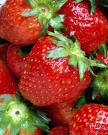 |
|---|---|---|
| Source or region: | Originally cultivated in Europe. | |
| Food or product: | Fresh, flavoring, Jams, Pies | |
| Color: | Red. Produces a light pinkish-orange tint in mead. | |
| Aroma: | Sweet, Strawberry esters | |
| Flavor: | Sweet, Strawberry. Fruit character is delicate and subtle. May add some tannin from seeds. Lower acidity than raspberries. Mildly flavored. |
Grape Varieties in Pyments
Most modern wine grapes are varieties of the species vitis vinifera, which is native to the Mediterranean region and central Europe. It is a widely adapted species and is grown on every continent except Antarctica. Most modern grapes based on v. vinifera are actually grafts onto North American rootstock of another species (such as v. labrusca), which was first done in the late 19th century after European vineyards were devastated by phylloxera.
When a single variety constitutes at least 75-85% of a wine (varying by law in country where produced), the result is a varietal wine named after the predominant grape. Many wines from the United States and Australia are produced as varietal wines. Wines with a mixture of grapes are known as blended wines. Blended wines are not inferior to varietal wines; in fact, most well-known French wines are blends of different varieties of the same vintage. European wines (French, Italian, German, Spain, etc.) are named for the region rather than the grape varieties used, although only certain varieties may be used by law in certain blended wines.
The concept of terroir is very important in the production of fine wines. It encompasses all environmental factors that produce a certain product, including the types of grapes used, the elevation and shape of the vineyard, the soil conditions and chemistry, climate and seasonal conditions, and local yeast cultures. This is how very unique wines are made from essentially the same ingredients. Mass-produced wines typically favor consistency at a low price, so the terroir is minimized.
The aroma and flavor of specific grape varieties will vary from year to year based on seasonal growing conditions, especially heat and rainfall. A range of descriptors is given for each variety, but don’t expect all the various components to be in every vintage. Various wine resources describe the character of grapes depending on whether they were grown in cool, moderate or hot climates. This is why wine vintages will vary greatly, and some are more prized than others.
Grape varieties are typically grown for either red wine or white wine usages, although some can be used for both applications. Red wine gets its color (and tannin) from contact with red grape skins. Red grapes can make white wine if the skins are separated from the juice at pressing. Wines that are designed to age are often oaked, red wines more frequently than white. When judging pyments, keep in mind the character contributed by the grape juice and separate it from the fermentation, conditioning and age character that can vary. Meadmakers will not always treat varietal grapes in the same way vintners will treat them, so stick to the varietal character of the grape more than the total impression of popular wines made from those grapes.
Cabernet Sauvignon
| Description: | Red wine grape. Grows everywhere, particularly in warm climates. Can age well, usually oak aged when used in wines. |
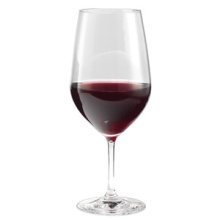 |
|---|---|---|
| Growing regions: | Bordeaux (France), Napa (US), Australia, Chile. | |
| Product: | Red Bordeaux and imitators, varietal US wine. | |
| Color: | Red grape. Dark, ruby red to dark purple, almost inky juice. |
 |
| Aroma: | Black currant, dark berries, leather, tobacco, cherry. | |
| Flavor: | Full-bodied, dense, dark, tannic. Medium to full bodied. Black currant, cassis, leather, tobacco, cherry. Often takes on additional flavors from oak. |
Chardonnay
| Description: | Most popular white wine grape in the US. Often oak fermented and/or aged. |
 |
|---|---|---|
| Growing regions: | Burgundy (France), Champagne (France), California (US), Australia. | |
| Product: | White Burgundy, Champagne, varietal US wine. | |
| Color: | White grape, pale yellow-green to yellow-gold juice. |
 |
| Aroma: | Apples, pears, tropical and citrus fruit. | |
| Flavor: | Medium acidity. Dry to medium-dry. Full bodied. Apples, citrus, peach, melon, tropical fruit. Can take on buttery and creamy flavors from malo-lactic fermentation. Can take on oaky, toasty, vanilla flavors from oak. |
Chenin Blanc
| Description: | White wine grape. |
 |
|---|---|---|
| Growing regions: | Loire (France), California (US), South Africa. | |
| Product: | Vouvray, white jug white. | |
| Color: | White. |
 |
| Aroma: | Citrus. | |
| Flavor: | Very high acidity, often slightly sweet to balance acidity. Crisp, tart, citrus. |
Concord
| Description: | Native US table grape, first cultivated in Massachusetts, vitis labrusca. |
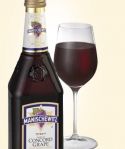 |
|---|---|---|
| Growing regions: | US. | |
| Product: | Grape jelly, grape juice, candy flavors, kosher-style wines like Manischewitz. | |
| Color: | Dark-colored purple-red juice, deep blue/purple-skinned grape. |
 |
| Aroma: | Strong. | |
| Flavor: | “Foxy,” musky, candied-strawberry. |
Gewürztraminer
| Description: | White wine grape. |
 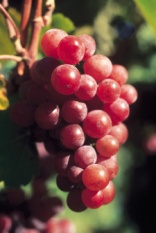 |
|---|---|---|
| Growing regions: | Alsace (France), Germany. | |
| Product: | Rhine wine, varietal French and US wine. | |
| Color: | Dark pink colored grape, producing a straw-yellow to yellow-gold colored juice/wine. | |
| Aroma: | Spicy, flowery, exotic fruit, candied apple, lychee, rose, honeysuckle. Ginger, clove, nutmeg, allspice. | |
| Flavor: | Light to medium body, low acidity. Flowery, spicy, exotic fruit, lychee, peach, mango, quince, candied ginger, pineapple. |
Merlot
| Description: | Red wine grape, most popular US red, used for blending in France to add body and softness to Cabernet Sauvignon. |
 |
|---|---|---|
| Growing regions: | Bordeaux (France), Napa, Washington, Long Island (US). | |
| Product: | Red Bordeaux, varietal US reds. | |
| Color: | Black skin, dark ruby red to deep purple-red juice. |
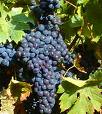 |
| Aroma: | Plum, dark berry, jammy, currant, tobacco, chocolate, cedar, blackberry, black cherry, fruitcake. | |
| Flavor: | Plum, berry, currant, chocolate. Medium to full body, fruity, medium tannins, soft, fleshy, more sugar but less tannin and malic acid than cabernet sauvignon. Can be oaky. |
Muscat
| Description: | Wine and table grape, many varieties, mostly white wine grape, although some red wine grapes are notable. |
 |
|---|---|---|
| Growing regions: | Asti (Italy), California (US), Alsace (France). | |
| Product: | Asti, Dessert wines. | |
| Color: | White to nearly black grapes; white is most commonly used in wine and mead. Straw-yellow to deep gold juice/wine. |
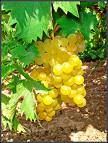 |
| Aroma: | Floral, orange blossom, honeysuckle, topical flowers, lily, hyacinth, Muscat grape, peach, mandarin orange, apricot, tangerine. | |
| Flavor: | Very floral and fruity, orange, apricot, marmalade and Muscat grape. One of very few wines that tastes like the raw grapes. |
Pinot Noir
| Description: | Red wine grape. Difficult to grow, challenging wine to make. |
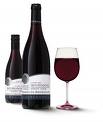 |
|---|---|---|
| Growing regions: | Burgundy, Champagne (France), Oregon, Central Coast of California (US). | |
| Product: | Red Burgundy, varietal US wine. | |
| Color: | Red. Dark pink to ruby red to violet juice/wine. |
 |
| Aroma: | Cherries, strawberry, raspberry, cranberry, spice, earthy, woody. | |
| Flavor: | Light to medium body, low tannins, medium-high acidity, silky. Strawberry, raspberry, cherry, red currants, spice, earthy, woody. |
Riesling
| Description: | Acidic white wine grape. Never oaked. Can age well, particularly German ones. |
 |
|---|---|---|
| Growing regions: | Germany (sweeter wines), Alsace (France, drier wine), New York (US), Washington (US). | |
| Product: | Rhine wine, varietal US wine. | |
| Color: | White grape. Juice is a pale yellow-green. |
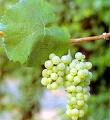 |
| Aroma: | Fruity, green apple, floral, honeysuckle, rose, violet, minerals. | |
| Flavor: | Light and refreshing. Fruity (apple, lemon, peach, apricot, pear, melon), floral (rose, violet), minerals. Light bodied. |
Sangiovese
| Description: | Red wine grape. |
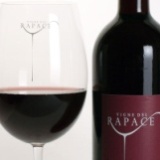 |
|---|---|---|
| Growing regions: | Chianti, Tuscany (Italy), California (US). | |
| Product: | Chianti. | |
| Color: | Purple-red grape. Deep purple-red juice/wine. |
 |
| Aroma: | Cherry, strawberry, violets, nutty, black pepper, spicy, plum. | |
| Flavor: | Tart cherry, berries, spice, violets, nutty, black pepper, tobacco. Medium-high acidity. Firm tannin. Light to full body. |
Shiraz (Syrah)
| Description: | Red wine grape, called Syrah in France and US, Shiraz in Australia. |
 |
|---|---|---|
| Growing regions: | Rhone (France), Australia, California (US). | |
| Product: | Rhone reds, Shiraz. | |
| Color: | Deep purple-black grapes. Deeply colored juice, from dark ruby red to inky purple. |
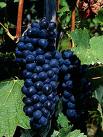 |
| Aroma: | Blackberry, black currant, berries, black pepper, clove, anise, cedar, incense, tar, smoked meat. | |
| Flavor: | Black currant, blackberries, berries, black pepper, cedar. Full body, firm tannin. Smoked meat, tar. |
Tempranillo
| Description: | Red wine grape. Main red grape of Spain. Made into moderate alcohol wines. |
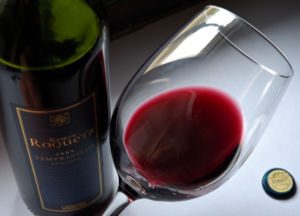 |
|---|---|---|
| Growing regions: | Spain. | |
| Product: | Rioja. | |
| Color: | Red, deep color. |
 |
| Aroma: | Cherry, berry, cedar, spice. | |
| Flavor: | Full-bodied. Low acidity. Cherry, berry, cedar, spice. |
Vidal
| Description: | White wine grape, vidal blanc. Thick skinned. Used to make sweet dessert wines, pressed from naturally-frozen grapes. |
 |
|---|---|---|
| Growing regions: | Niagara (Canada), New York (US). | |
| Product: | Canadian Icewine. | |
| Color: | White. |
 |
| Aroma: | Fruity, grapefruit, pineapple, lychee. Floral, apricots, crème caramel. | |
| Flavor: | High acidity and fruitiness. Floral, resinous, pineapple, grapefruit, melon, hazelnuts, pears, orange blossoms. Flinty, minerally, viscous. |
Zinfandel
| Description: | Red wine grape. Can age well, depending on style. Tends to make higher alcohol wines. |
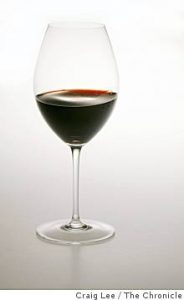 |
|---|---|---|
| Growing regions: | California (US). | |
| Product: | Varietal US wine. | |
| Color: | Deep red color. |
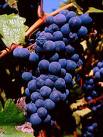 |
| Aroma: | Raspberry, blackberry, jammy, spicy. | |
| Flavor: | Robust. Blackberry, raspberry, spicy, jammy, fig, blueberry, sometimes chocolate. Broad range from light and fruity to big and rich. Medium to full body. |
Cider Apples and Perry Pears
There are thousands of varieties of apples and pears, a great many of which may be used for cider and perry. In general a cider apple or perry pear should feature at least one of the following: high sugar content for potential alcohol and preservation, acidity (high for preservation, low to balance a high acid blend), interesting tannins, or an inviting aroma. A small sampling of popular apples and pears used for cider and perry is provided below. It is far from complete and judges are encouraged to try new varietals when the opportunity arises.
Cider and perry are often compared to wine, with myriad words used to describe grapes and their fermented products. It is important to note that terroir differences among apple and pear varietals can be vast, as can the impression they make on the nose and palate. As such you will find few specific flavor or aroma characters mentioned in the fruit descriptions below. Simply put, apples and pears can vary, and judges should not overtly focus on the few specific flavors mentioned. Any specific characters listed are fairly common – not required – for that particular variety of apple/pear. When the guidelines say “If specified, varietal character will be expected” we are speaking of the general theme of the apple/pear, not a checklist of specifics that the cider/perry maker must pass.
This does not mean you cannot identify specific characters on a scoresheet. As with Beer Judges, if a Cider Judge tastes or smells a specific fruit, spice, or other identifiable character, they should write it down. Lychee, olive, apricot, white wine or concord grapes, rose, orchard floor, mushroom, sweat, coconut – all are characters that have been attributed to multiple apples that have been used for cider. Do not be concerned if you perceive a specific varietal differently than most people; you are there to describe what you are experiencing and as such there is no wrong answer.
Apples may generally be divided into Sweet (low acid, low tannin), Sharp (high acidity, low tannin), Bittersweet (low acid, high tannin) and Bittersharp (high acid, high tannin). Naturally the levels of sugar, acidity, and tannin in apples all exist on continuums and many varietals blur these dividing lines, so you may sometimes see apples referred to as Sweet-Sharp, or as various levels among a category such as Mild/Moderate/Full Bittersharp. Expect significant variation in where the fruit fits on the sugar/acid/tannin scales based on terroir. Tannins can usually be broken down further into soft (astringent) or hard (bitter), with many apples exhibiting both. Soft tannins are generally welcome in a wider variety of ciders, refreshing the palate and inviting another sip, while at a high level bitterness can convey harshness and detract from drinkability.
Apples for Cider
Ashmead’s Kernel
| Type: | Sharp |
|---|---|
| Acidity: | High |
| Sugar: | High |
| Appearance: | Heavy russeting with an orange skin on the sun side. |
| History: | Originated in Gloucester, England in the 1700’s from a chance seedling. |
| Other Characteristics: | Intensely flavored and aromatic. High sugar and acidity give it a rich complex flavor featuring tropical fruit or citrus, especially lemon. May be too acidic to eat at harvest but may occasionally be used as a single varietal. |
Baldwin
| Type: | Sharp |
|---|---|
| Acidity: | High |
| Sugar: | High |
| Appearance: | Large conical apple with yellow skin which is covered by red on the sun side. |
| History: | First discovered in Massachusetts around 1740, it was introduced commercially around 1784 and by 1850 it had become became the most widely grown apple in the United States. In the 1934 an extremely cold winter killed over half of the trees. At that time it was largely replaced by the more- cold hardy McIntosh. |
| Other Characteristics: | Creamy white flesh with a spicy flavor. Has high acidity especially immediately after picking that mellows with storage. Baldwin apples are not intensely flavored, but the sugar, acidity and aromatic juice offer many positive characteristics for cider, and occasionally is used to make a single-varietal cider. |
Dabinett
| Type: | Bittersweet |
|---|---|
| Acidity: | Low |
| Sugar: | Medium to High |
| Appearance: | Small round apple with yellow-green skin and red highlights. |
| History: | Discovered in Somerset, England in the mid 1800’s, and is believed to be a chance seedling of Chisel Jersey. Currently Dabinett is one of the most widely grown varieties in modern English orchards. |
| Other Characteristics: | Considered a classic full bittersweet with vintage qualities. The tannins provide a mixture of soft astringency with some hard bitterness that gives a full body to cider. Moderate bittersweet apple aromas of orchard floor/overripe apple are common. |
Douce Moen
| Type: | Bittersweet |
|---|---|
| Acidity: | Low |
| Sugar: | High |
| Appearance: | Small round fruit, red over green skin, midseason ripening. |
| Other Characteristics: | The most-planted French cider apple; a mild bittersweet with moderate astringency. |
Esopus Spitzenburg
| Type: | Sharp |
|---|---|
| Acidity: | High |
| Sugar: | High |
| Appearance: |
Medium to large size, color ranges from all red to a mixture of red with varying amounts of orange, yellow and green. |
| History: | Originated in Esopus, New York in the late 1700’s, and was widely planted across the US in the 19th century. This apple was reported to be a favorite of Thomas Jefferson. |
| Other Characteristics: |
Aromatic, spicy and richly flavored giving some the impression of citrus or caramelized apples. Acid is quite high when picked but mellows in storage and allows the flavor to develop depth and complexity. |
Gold Rush
| Type: | Sweet to Sharp |
|---|---|
| Acidity: | High |
| Sugar: | High |
| Appearance: | Medium to large sized round apple with yellow-green skin, often with a light reddish blush. |
| History: | A cross of Golden Delicious and Co-op 17 developed by Purdue in 1972. |
| Other Characteristics: | Spicy sweet-tart flavor at harvest. The apple is an excellent keeper that lasts for months in storage and allows the high acidity to mellow and develop a high sugar level. Storage develops richness in the flavor, with honey and spice notes coming through. |
Golden Russet
| Type: | Sweet to Sharp |
|---|---|
| Acidity: | High to Very High |
| Sugar: | Very High |
| Appearance: | Medium sized apple with heavily russeted golden / bronze skin. |
| History: | First appeared in the US around 1850 but may have originated in Europe perhaps as early as the 1700’s. |
| Other Characteristics: | Considered to be one of the very best American cider apples. Whereas many apples are known for distinctively “appley” characteristics, the Golden Russet tends to create cider showing other fruits, with peach, pear, and tropical fruits common. Golden Russets are rich and aromatic and the sugar levels allow a high potential alcohol, thus ciders made with this good keeper with can be especially wine-like. |
Gravenstein
| Type: | Summer Apple, Sharp |
|---|---|
| Acidity: | Medium |
| Sugar: | Medium |
| Appearance: | Large apple covered in a mix of reddish orange and yellow streaks. |
| History: | Originated in Denmark or Italy in the 1600’s and imported to the US from Europe in the 1790’s. |
| Other Characteristics: | Likely the most well-known of the summer apples, but featuring higher sugar and more initial crunch then most early season apples. Very poor keeper, with tender crispness quickly softening with any storage. Aromatic, and distinctive, sometimes with hints of honey. |
Harrison
| Type: | Bittersweet to Sharp |
|---|---|
| Acidity: | Low |
| Sugar: | High |
| Appearance: | A small yellow green apple that turns yellow during storage. |
| History: | Discovered near Newark, New Jersey in the early 1700’s, by the 1800’s Harrison’s Sparkling Newark Cider was well known. During prohibition orchards switched to dessert apples and Harrison was forgotten. In 1976 a single tree was found growing near an old cider mill and cuttings were used to propagate new trees. |
| Other Characteristics: | Known for producing a juice that is rich, syrupy and very dark colored. Has enough tanning and acid to make an excellent single varietal cider. |
Jonathan
| Type: | Sharp |
|---|---|
| Acidity: | Medium to High |
| Sugar: | Medium |
| Appearance: | Medium-sized round fruit, mostly red over a yellow skin. |
| History: | Originating in Woodstock, New York sometime in the 1790’s, as a seedling of Esopus Spitzenberg, this apple is often grown in the upper Midwest / Great Lakes regions. |
| Other Characteristics: | One of the few self- fruitful apple trees. Has a flavor often described as “intensely appley or red apple” a mix of sweet/ tart / spicy. Parent of many other varieties such as Idared, Jonagold, Jonamac and Melrose. |
Jonagold
| Type: | More Sweet than Sharp |
|---|---|
| Acidity: | Medium |
| Sugar: | Medium |
| Appearance: | Medium-sized round fruit, mostly red over a yellow skin. |
| History: | A New York Agricultural Experiment Station 1968 release of an earlier cross of Jonathan and Golden Delicious. |
| Other Characteristics: | Picking up the acid from its Jonathan side and the honeyed apple sweetness from its Golden Delicious parent, the apple is balanced between sweet and tart that can make a clean base for more interesting apples in a blend, or even create a good, though simple, single varietal cider. |
Kingston Black
| Type: | Bittersharp |
|---|---|
| Acidity: | Medium |
| Sugar: | High |
| Appearance: | Small apple with dark red / purple skin with light colored russeting. |
| History: | Discovered in Somerset, England in the early 1800’s. |
| Other Characteristics: | Often called one of the few apples capable of creating a good single variety cider. Difficult to grow and tends toward biennial production. Apple has fairly high levels of sugar, moderate levels of acid and tannin, as well as very distinctive flavors and aromatics. One of the few apples you may recognize immediately, though be sure you are not confusing some of the more savory, mushroom, or funky qualities with that of MLF. |
McIntosh
| Type: | Sweet to Sharp |
|---|---|
| Acidity: | Medium |
| Sugar: | Medium |
| Appearance: | Small moderately-flattened shape, the color is a mix of bright red and green that may include stripes. The apple possesses a thick, tough and waxy skin that many people dislike eating. |
| History: | Originated in Ontario, Canada in the late 1700’s or early 1800’s and is a seedling of Fameuse. McIntosh is the parent of many varieties of apples such as Lobo, Empire and Cortland. |
| Other Characteristics: | The distinctive flavor is often called spicy, appley or ciderlike. This intense apple character has made some sweeter McIntosh ciders come across as a bit raw or juicelike. |
Medaille d’Or
| Type: | Bittersweet |
|---|---|
| Acidity: | Low |
| Sugar: | High |
| Appearance: | Small oblong apple with a golden yellow skin covered with light russeting. |
| History: | Discovered in the mid 1800’s in Normandy, France. |
| Other Characteristics: | Extremely high tannins, however as they are soft, astringent tannins and the apple also has high to extremely high sugar, it can be eaten fresh without the harsh bitterness of many other bittersweets. |
Northern Spy
| Type: | Sharp |
|---|---|
| Acidity: | High |
| Sugar: | High |
| Appearance: | The apple is mostly red with pink or orange blush or streaks near the top, and though thin skinned and easily bruised, is a very good keeper. |
| History: | Discovered in 1800 in Bloomfield, New York, and is thought to have come from seeds originating in Connecticut. It may have been called Northern Pie or Northern Spice at one point. |
| Other Characteristics: | A multi-use apple including cider, eating, cooking and pie. Has a mix high acid and high sugar, with a moderately rich fruity flavor and aroma. |
Newtown Pippin
| Type: | Sharp |
|---|---|
| Acidity: | High |
| Sugar: | Medium |
| Appearance: | This fairly large apple is pale green to greenish-yellow and occasionally red-blushed or russeted. |
| History: | Originated from a seedling on Long Island, New York in the early 1700’s and was widely revered by the nation’s founders. It is also known by several other names including Yellow Newtown Pippin and Albemarle Pippin. |
| Other Characteristics: | Great dessert and baking apple that also makes a terrific cider. Moderate sugar, very high acid and fairly distinctive flavor sometimes described as pineapple or tart citrus such as tangerine, lemon, lime. |
Reine des Reinettes
| Type: | Bittersharp |
|---|---|
| Acidity: | High |
| Sugar: | High |
| Appearance: | Very hard and dense with partial russeting over red skin tinted with orange. |
| History: | Believed to have originated in the Netherlands, or some other region of northern Europe, in the 1700’s. Became very popular in France and is used to make the French pastry Tate Tartin. |
| Other Characteristics: |
Rich in flavor and aroma (florals, citrus, and tropical notes are common). Also has light to moderate soft astringency. |
Roxbury Russet
| Type: | Sweet |
|---|---|
| Acidity: | High |
| Sugar: | High to Very High |
| Appearance: | Medium to large round apple with coarse russeting covering greenish yellow skin, sometimes develops a red tint on one side. |
| History: | Generally recognized as the oldest cultivated North American variety of apple. It originated near Boston prior to 1650, likely as a seedling from a tree previously brought by European colonists. |
| Other Characteristics: | High sugar and fairly high acid, when first picked acid completely dominates sweetness, mellows in storage and develops a complex flavor that is more sweet then tart. |
Stoke Red
| Type: | Bittersharp |
|---|---|
| Acidity: | High |
| Sugar: | Medium |
| Appearance: | A small to medium sized apple with dark red patches over a green and yellow skin. |
| History: | It was found growing in Rodney Stoke, Somerset, England in the 1920’s. |
| Other Characteristics: | The apple produces a sharp juice with soft tannins that gives a distinctive astringency. Can be used to add a bittersharp component to a blend and is also considered to make a high quality single varietal cider. |
Virginia (Hewe’s) Crab
| Type: | Sharp, Crabapple |
|---|---|
| Acidity: | High |
| Sugar: | Very High |
| Appearance: | A small round apple with bright pink stripes over a yellow green skin. |
| History: | Originated in Virginia around 1700. |
| Other Characteristics: | Has long had a reputation as an excellent cider apple with high sugar and high acidity. Produces a juice that is very astringent and is occasionally used as a single-varietal. Sugar levels are high enough to produce intensely-flavored cider with 10% ABV without chaptalization. |
Wickson
| Type: | Sharp, Crabapple |
|---|---|
| Acidity: | Very High |
| Sugar: | Very High |
| Appearance: | Very small bright red over yellow delicate skin. Oblong fruit, about 1.5-2”. Like a tiny apple or a large crab. |
| History: | Offspring of Newtown and Spitzenburg crabs (not to be confused with cider apples of similar names) by Albert Etter in the early 1940’s. |
| Other Characteristics: | Extremely high acid, intensely aromatic, near water-white juice that may also produce sugar levels as high as 25 Brix. |
Winesap
| Type: | Sharp |
|---|---|
| Acidity: | Medium |
| Sugar: | Medium |
| Appearance: | Small to medium sized, round apple has deep red to maroon color with some yellow on the shaded side. |
| History: | Was once one of the most widely planted apples in America, and is believed to have originated in New Jersey sometime in the late 1700’s. Is the parent of many other varieties such as Arkansas Black, Black Twig, and Stayman. |
| Other Characteristics: | Great keeping apple. The flavor is more sweet then tart, and often has a vinous character that some people find “foxy” or savory. |
Yarlington Mill
| Type: | Bittersweet |
|---|---|
| Acidity: | Low |
| Sugar: | High |
| Appearance: | Large, round apple with red streaks over yellow colored skin. |
| History: | The original tree was found growing near a water wheel in Yarlington, England in 1898. |
| Other Characteristics: | Considered a medium bittersweet of vintage quality, with moderate orchard floor bittersweet apple aroma. Compared to Dabinett, Yarlington Mill generally exhibits a softer, more astringent tannin profile with less bitterness. |
Pears for Perry
Barland
| Type: | Bittersharp |
|---|---|
| Acidity: | High |
| Sugar: | Medium |
| Appearance: | A small to medium round sized pear, slender, with patches of green and yellow skin. |
| History: | An old variety, well known in the 17th century and formerly widely planted. |
| Other Characteristics: | Known for medium to high tannins, fruity flavor, and astringency. |
Barnet
| Type: | Sweet |
|---|---|
| Acidity: | Low |
| Sugar: | Low to Medium |
| Appearance: | A small round sized pear with green and yellow skin and orange-red flush. |
| History: | A small round sized pear with green and yellow skin and orange-red flush. |
| Other Characteristics: | Known for low to medium tannins and astringency. |
Blakeney Red
| Type: | Medium Sharp |
|---|---|
| Acidity: | Medium |
| Sugar: | Medium |
| Appearance: | A small sized pear with yellow skin and heavy red flush. |
| History: | Widely planted in the 19th century. |
| Other Characteristics: | Known for low tannins. Also suitable for eating. |
Brandy
| Type: | Medium Sharp |
|---|---|
| Acidity: | Medium |
| Sugar: | High |
| Appearance: | A small sized pear with green to greenish yellow skin and bright red flush. |
| History: | Popular in the 19th century but has diminished a bit. |
| Other Characteristics: | Known for low tannins, mild juice, being aromatic, and for making strong perry. |
Butt
| Type: | Bittersharp |
|---|---|
| Acidity: | Medium to High |
| Sugar: | Medium |
| Appearance: | A small sized pear with yellow to greenish yellow skin and yellow tinged flush. |
| History: | Very popular variety. Heavy crops and keeps well. |
| Other Characteristics: | Known for medium to high tannins, fruitiness, and astringency. |
Gin
| Type: | Medium Sharp |
|---|---|
| Acidity: | Medium to High |
| Sugar: | Medium |
| Appearance: | A small sized pear with green to greenish yellow skin and yellow tinged flesh. |
| History: | Widely planted and very popular. |
| Other Characteristics: | Known for medium to high tannins, being astringent, fruity, and average to good quality. |
Hendre Huffcap
| Type: | Medium Sharp |
|---|---|
| Acidity: | Low to Medium |
| Sugar: | Medium to High |
| Appearance: | A small elliptical or irregular shaped pear with green, greenish yellow, or yellow skin and slight orange flush. |
| History: | Widely planted and very popular. |
| Other Characteristics: | Known for low to medium tannins, pleasant, light, and very good quality. |
Red Pear
| Type: | Sweet |
|---|---|
| Acidity: | Low |
| Sugar: | Medium |
| Appearance: | A small round sized pear with yellow to greenish yellow skin and red flush. |
| History: | An average quality fruit that has been popular for over 400 years. |
| Other Characteristics: | Known for low tannins and astringency. |
Taynton Squash
| Type: | Medium Sharp |
|---|---|
| Acidity: | Medium |
| Sugar: | Medium |
| Appearance: | A small round shaped pear with greenish yellow skin and reddish brown flush. |
| History: | Known for heavy crops. |
| Other Characteristics: | Known for low to medium tannins, slightly sweet, and average quality. |
Thorn
| Type: | Medium Sharp |
|---|---|
| Acidity: | High |
| Sugar: | High |
| Appearance: | A small round shaped pear with yellow skin and orange flush. |
| History: | Originally planted in the late 1600s as a dessert pear. |
| Other Characteristics: | Known for high tannins, astringency, heavy cropping, and hardiness. |
Winnals Longdon
| Type: | Medium Sharp |
|---|---|
| Acidity: | Medium to High |
| Sugar: | Medium to High |
| Appearance: | A small round shaped pear with greenish yellow or yellow skin and heavy red flush. |
| History: | Heavily cropped going back to the late 1700s. |
| Other Characteristics: | Known for low to medium tannins, heavy cropping, and good quality. |
Yellow Huffcap
| Type: | Medium Sharp |
|---|---|
| Acidity: | Medium to High |
| Sugar: | High |
| Appearance: | A small round shaped pear with green, yellow, or yellowish black skin and yellow green flesh. |
| History: | Heavily cropped going back to the late 1700s. |
| Other Characteristics: | Known for low tannins, full flavor, and excellent quality. |
Spices
Metheglins are spiced meads, but the BJCP is somewhat liberal in defining spice for this purpose. Certainly the botanical definition of spice isn’t used, since herbs, vegetables and other flavorings fit into this category. Don’t get hung up about the technical definitions; the style categories are defined with specific examples to help entrants know where to enter their meads.
This list contains various mead flavorings that are popular among competition entrants. It also includes some additional fermentables (agave nectar and maple syrup) that would not be used in metheglins. Meads with additional fermentables should be entered as Open Category meads. Regardless, the spicing components listed in this section are related to the ingredient question on the exam dealing with spices in mead.
Agave Nectar
| Description or Definition: | Nectar from the agave plant; largely fructose, low-glycemic honey substitute. Blue agave (Agave tequilana) is generally best in Mead. A commercial sweetener in Mexico. |
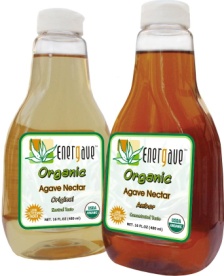 |
|---|---|---|
| Source or Region: | SW US, Mexico. | |
| Food or product: | Agave Nectar, sweetener in many food products. | |
| Color: | Ranges in color from light to dark, depending on degree of processing. |
 |
| Aroma: | Sweet. | |
| Flavor: | Sweet, mild, neutral taste (light color) to more caramel-flavored (darker color). Sweeter than honey but less viscous. |
Allspice
| Description or Definition: | Dried unripe fruit of the Pimenta dioica plant; the green berry of a tropical evergreen, which is dried |
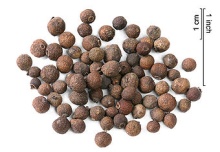 |
|---|---|---|
| Source or Region: | West Indies. | |
| Food or product: | Caribbean Jerk, mole sauce, pickling, curry sauces, pumpkin pie spice. | |
| Color: | Dark reddish-brown. |
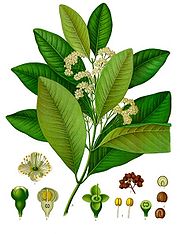 |
| Aroma: | Combination of cinnamon, clove, and nutmeg. | |
| Flavor: | Tastes like a combination of cinnamon and cloves but hotter and peppery. Slight astringency. Some tongue-numbing qualities of clove. |
Black Pepper
| Description or Definition: | Seasoning produced from the fermented, dried, unripe red berries of the plant Piper nigrum. |
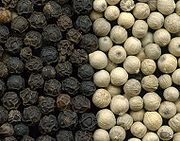 |
|---|---|---|
| Source or Region: | Originated in southern India and Sri Lanka. | |
| Food or product: | Common table seasoning in western cuisines. | |
| Color: | Black. |
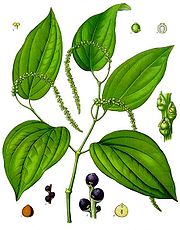 |
| Aroma: | Peppery, pungent, aromatic. | |
| Flavor: | Peppery, spicy, accents flavors, has some heat, slightly earthy. |
Black Tea
| Description or Definition: | Fermented tea leaves. |
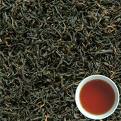 |
|---|---|---|
| Source or Region: | Mainland China, India, Sri Lanka, Taiwan, Japan, Nepal, Australia, Kenya – named for the region of origin. | |
| Food or product: | Black tea. | |
| Color: | Black. |
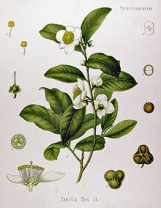 |
| Aroma: | Herbal. | |
| Flavor: | Tannic, bitter. |
Cardamom
| Description or Definition: | Seed pod of Elettaria cardamomum (green cardamom). |
 |
|---|---|---|
| Source or Region: | India. | |
| Food or product: | Common in Indian cooking and baking in Nordic countries. | |
| Color: | Black seed from green pods. |
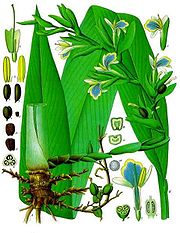 |
| Aroma: | Intensely aromatic fragrance, citrus, bright, sandalwood, cinnamon. | |
| Flavor: | Strong, unique, bright, resiny taste. Astringent, not bitter, with a coolness similar to mint, though with a different aroma. Slightly numbing. Lingering aftertaste. |
Chai Tea
| Description or Definition: | Black tea brewed with spices including cinnamon, cardamom, cloves, pepper and ginger, star anise, peppercorn, cloves. |
 |
|---|---|---|
| Source or Region: | India. | |
| Food or product: | Expensive trendy lattes. | |
| Color: | Tan. | |
| Aroma: | Can consist of a variety of spices including cinnamon, cardamom, cloves, pepper, ginger, star anise, peppercorn, and cloves but no single spice should stand out alone. | |
| Flavor: | Spicy, slightly astringent, including cinnamon, cardamom, cloves, pepper, ginger star anise, peppercorn, cloves but no single spice should stand out alone but should be a blend of spices. |
Chamomile
| Description or Definition: | Dried flowers of Camaemelum nobile. |
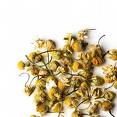 |
|---|---|---|
| Source or Region: | Europe and Asia. | |
| Food or product: | Tea. | |
| Color: | White. |
 |
| Aroma: | Apple-like, berries, honey, citrus, rose. | |
| Flavor: | Soft, apple-like, honey, berries, citrus, rose. |
Chipotle
| Description or Definition: | Smoked mature (red) jalapeño. |
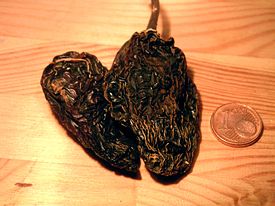 |
|---|---|---|
| Source or Region: | SW US, Northern Mexico. | |
| Food or product: | Used to flavor soups, salsas, stews, sauces. | |
| Color: | Dark red-brown to almost black. |
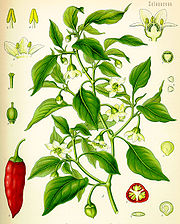 |
| Aroma: | Smoky. | |
| Flavor: | Smoky, hot, jalapeño chile, nutty, spicy. Approximately 3,000 Scoville units. |
Chocolate
| Description or Definition: | Made from the fermented, roasted and ground seeds of the tropical cacao tree. |
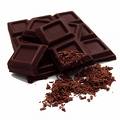 |
|---|---|---|
| Source or Region: | Mexico, Central & South America. | |
| Food or product: | Truffles, cocoa. | |
| Color: | Dark brown. |
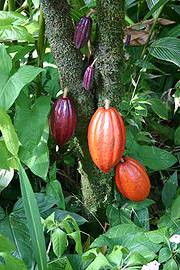 |
| Aroma: | Chocolate. | |
| Flavor: | Chocolate. |
Cinnamon
| Description or Definition: | Inner bark of a small evergreen tree, Cinnamomum zeylanicum, the essential oils found in the bark give the aroma and flavor, Cassia is often used as a less expensive substitute. |
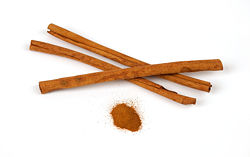 |
|---|---|---|
| Source or Region: | Southeast Asia, Sri Lanka, China. | |
| Food or product: | Combined with other spices in many foods, atomic fireball candies. Cinnamon toast. | |
| Color: | Light brown to darker orange-brown. |
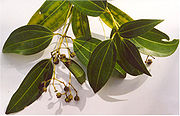 |
| Aroma: | Cinnamon. Spicy-hot. Pungent, warm, appealing. | |
| Flavor: | Hot, cinnamon, warming, spicy. |
Clove
| Description or Definition: | Dried aromatic flower bud of the clove tree, essential oil of clove has anesthetic and antimicrobial qualities. |
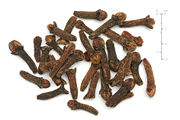 |
|---|---|---|
| Source or Region: | Indonesia, Madagascar. | |
| Food or product: | Fragrances, baked products. | |
| Color: | Very dark brown. |
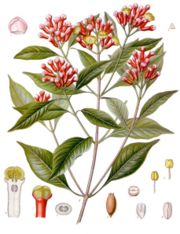 |
| Aroma: | Strongly aromatic, earthy to musty, fragrant, somewhat sweet. | |
| Flavor: | Strong, biting, tongue-numbing. |
Coffee
| Description or Definition: | Roasted bean of the Coffea arabica plant. |
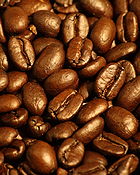 |
|---|---|---|
| Source or Region: | Tropics. Originated in Ethiopia. | |
| Food or product: | Coffee, espresso, Kahlua. | |
| Color: | Brown. |
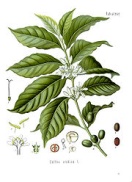 |
| Aroma: | Roasty, coffee. | |
| Flavor: | Roasty, coffee. Harsh when boiled. |
Coriander
| Description or Definition: | Seed of the coriander plant, Coriandrum sativum. The leaf is sometimes known as cilantro. |
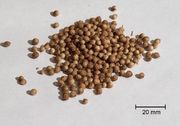 |
|---|---|---|
| Source or Region: | China, India, Mexico. | |
| Food or product: | A main ingredient of curry. | |
| Color: | Light tan. |
 |
| Aroma: | Citrusy, lemony, sweet, appealing, strong. | |
| Flavor: | Lemony, citrusy, spicy, estery. Some varieties have a vegetal, celeryseed flavor. |
Ginger
| Description or Definition: | Smooth-skinned, plump, tan to medium brown rhizome of Zingiber officinale, with a larger central root and smaller buds. The skin and outer layers are fibrous, the inner core is pale yellowish, firm and very juicy and fragrant. |
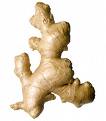 |
|---|---|---|
| Source or Region: | India, Jamaica, China. | |
| Food or product: | Ginger ale, Asian foods. Candied ginger. Ground ginger. Pickled ginger. | |
| Color: | Light yellow to pink flesh, light brown peel. Younger roots have a pinkish tinge. |
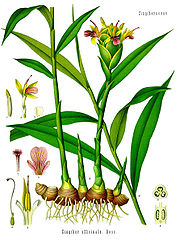 |
| Aroma: | Ginger. | |
| Flavor: | Ginger, hot, spicy, sharp, peppery. Full, slightly astringent. Flavor and heat will mellow with time in a mead. Very strongly flavored. |
Hazelnut (filbert)
| Description or Definition: | Nut or fruit of the hazel tree. |
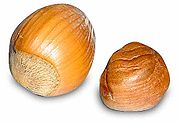 |
|---|---|---|
| Source or Region: | Southern Europe, Oregon, Washington. | |
| Food or product: | Frangelico, Praline, Nutella. | |
| Color: | White. |
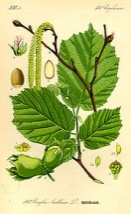 |
| Aroma: | Nutty. | |
| Flavor: | Nutty, bitter, almond-like. |
Heather Tips
| Description or Definition: | Tiny purple blooms of the Scottish shrub Calluna vulgaris. |
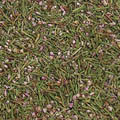 |
|---|---|---|
| Source or Region: | Scotland. | |
| Food or product: | Scottish Heather Ale, fragrances, Drambuie. | |
| Color: | Light purple-pink. |
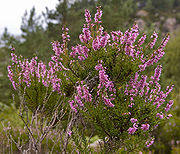 |
| Aroma: | Floral, delicate. | |
| Flavor: | Floral, bitter, buttery, honey-like. |
Lavender
| Description or Definition: | Flower in the mint family, Lavandula augustifolia. |
 |
|---|---|---|
| Source or Region: | Native to the Mediterranean region. | |
| Food or product: | Fragrances, bath soap. | |
| Color: | Pale purple. |
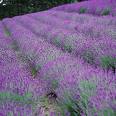 |
| Aroma: | Floral, lavender, perfume, slightly sweet. | |
| Flavor: | Floral, sweet. |
Lemongrass
| Description or Definition: | Stalk of Cymbopogon citratus. |
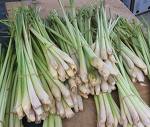 |
|---|---|---|
| Source or Region: | Southeast Asia. | |
| Food or product: | Thai food. | |
| Color: | Pale green. |
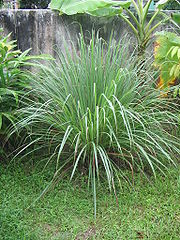 |
| Aroma: | Lemony, soft. Can be woody with cedar, ginger, sandalwood notes if higher quantities used. | |
| Flavor: | Refreshing, light, hint of ginger, citrus. Earthy, moderate |
Maple Syrup
| Description or Definition: | Boiled sap from sugar maple trees, Acer saccharum. |
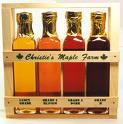 |
|---|---|---|
| Source or Region: | Northeast US, Canada. | |
| Food or product: | Breakfast syrup, candies. | |
| Color: | Pale to dark amber. |
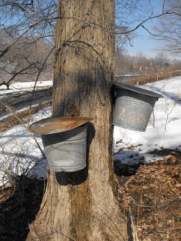 |
| Aroma: | Sweet, caramel, vanilla, maple, nutty. | |
| Flavor: | Sweet, caramel, vanilla, maple, nutty, sometimes a little smoky. |
Mint
| Description or Definition: | Leaves of the perennial herb in the Mentha genus, many varieties exist – most common are spearmint and peppermint. |
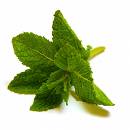 |
|---|---|---|
| Source or Region: | Native to Europe, Asia, Africa. | |
| Food or product: | Mint jelly, iced tea flavoring. | |
| Color: | Bright green. |
 |
| Aroma: | Sharp, refreshing, minty. Other aromatics vary by variety, can be peppery, pineapple, apple, chocolate, lemon, etc. | |
| Flavor: | Sharp, refreshing, minty. |
Nutmeg
| Description or Definition: | Seed of Myristica fragrans, which also produces Mace (the fleshy webbed skin that envelops the seed). |
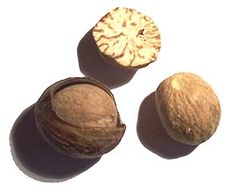 |
|---|---|---|
| Source or Region: | Southeast Asia, Indonesia, Australia. | |
| Food or product: | Eggnog topping, mulled wine. | |
| Color: | Light tan. |
 |
| Aroma: | Nutmeg, fleeting. | |
| Flavor: | Nutmeg, soft, delicate, rich, complex, lacks astringency, slightly sweet. |
Orange Peel
| Description or Definition: | Fruit peel of the orange. Fresh or dried. |
 |
|---|---|---|
| Source or Region: | Curaçao for bitter orange peel. | |
| Food or product: | Bitter – Belgian Wit beers, Sweet – Grand Marnier. | |
| Color: | Pale to bright orange. |
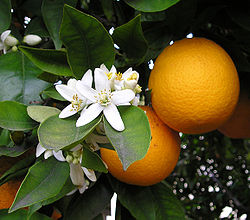 |
| Aroma: | Orange. | |
| Flavor: | Sweet or bitter, orange. |
Poblano
| Description or Definition: | Mild chile pepper, sometimes known as a pasilla. When dried is called an Ancho. |
 |
|---|---|---|
| Source or Region: | Mexico. | |
| Food or product: | Chile Relleño. | |
| Color: | Dark purplish-green. Can get a dark reddish-black when mature. |
 |
| Aroma: | Fresh pepper aroma but with some spicy heat. | |
| Flavor: | Like green pepper, but with a mild to moderate heat. Approximately 1,000 Scoville units. |
Rose Petals
| Description or Definition: | Petals of the genus Rosacea. Literally thousands of varieties exist. |
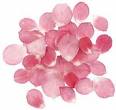 |
|---|---|---|
| Source or Region: | North America, France. | |
| Food or product: | Rosewater, perfume. | |
| Color: | White, pink, dark red, many other colors. |
 |
| Aroma: | Soft, perfumy, flowery, rose. Varies by variety. Can be quite aromatic and perfumy. | |
| Flavor: | Perfumy, soft, rose. Varies by variety. |
Rosemary
| Description or Definition: | Leaves of the perennial shrub. |
 |
|---|---|---|
| Source or Region: | Mediterranean region. | |
| Food or product: | Mediterranean Cuisine. | |
| Color: | Green. |
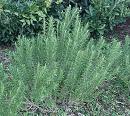 |
| Aroma: | Sharp, strong, herbal, evergreen. | |
| Flavor: | Bitter, astringent, evergreen. |
Saffron
| Description or Definition: |
Dried stigmas from crocus sativus. |
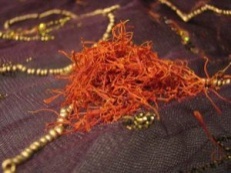 |
|---|---|---|
| Source or Region: | Native to Southwest Asia. Spanish saffron is regarded as the finest. Grown in Southern Europe and Asia. Iran produces the bulk of saffron currently. | |
| Food or product: | Risotto Milanese, paella. | |
| Color: | Deep yellow-gold, often with a light gold-orange hue. |
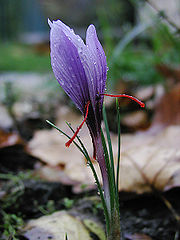 |
| Aroma: | Exotic, pungent, not sweet, distinctive, dried hay, honey, musk, inviting. | |
| Flavor: | Unique, exotic, slightly bitter. Saffron must be heated (or “bloomed”) to release the flavor. Can be unpleasant if overdone, often tasting medicinal and metallic. Very strongly flavored. |
Spruce Tips
| Description or Definition: | Fresh growth on spruce trees. |
 |
|---|---|---|
| Source or Region: | Found in the Northern temperate and boreal regions of the earth. | |
| Food or product: | Spruce beer. | |
| Color: | Green. |
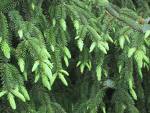 |
| Aroma: | Citrusy, piney, floral, fruity. | |
| Flavor: | Citrusy, piney, floral, fruity, resinous. |
Star Anise
| Description or Definition: | Star shaped fruit or seed of the Illicium verum tree. |
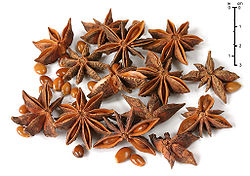 |
|---|---|---|
| Source or Region: | Native to China. | |
| Food or product: | Chinese cuisine, five-spice powder, garam masala, ph?. | |
| Color: | Dark reddish-brown. |
 |
| Aroma: | Anise, black licorice, complex. | |
| Flavor: | Anise, black licorice, slightly sweet. |
Vanilla
| Description or Definition: | Seed pod of orchid Vanilla planifolia. |
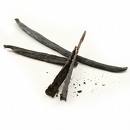 |
|---|---|---|
| Source or Region: | Tropics, hot and humid climates. | |
| Food or product: | Ice cream, pudding, custard, dessert sauces. | |
| Color: | Light brown. |
|
| Aroma: | Vanilla, sweet, full, penetrating. | |
| Flavor: | Vanilla, soft but strong, not bitter. Provides a fullness of flavor that can be used alone or to enhance other flavors. |
- Gordon Strong
- Susan Ruud
- Kristen England
- Ken Schramm
- Curt Stock
- Petar Bakulic
- Michael Zapolski, Sr. (Hightest)
Revised 2014 by Steve Piatz
Change Log
| Date | Change |
| March 2014 | removed from the Mead Exam Study Guide |
| March 2016 | moved to WordPress |
| February 2018 | Apples and Pears for Cider and Perry added. |
Copyright © 1998-2018 by the authors and BJCP, Inc.


